Bougainvillea Care Tips For This Flowering Machine
If you live in a temperate climate and want an (almost) year-round floral fiesta of vibrant color, then bougainvillea is the plant for you. I’m sharing bougainvillea care tips, a plant I have a lot of experience with, in two different hardiness zones.
There are many different types of bougainvillea. Depending on the variety, it can be grown on a trellis or over an arbor, against a building, fence, or wall, in containers, as a hedge or ground cover, in tree form, and as a bonsai.
Bougainvillea species and varieties can grow from 1′ to 8′ to 30′. There are quite a few dwarf varieties of bougainvillea (not really dwarf, but they stay under 6′) on the market now if you don’t want the maintenance that goes along with one that grows to 25′.
These are the bougainvilleas I’ve seen most often: Barbara Karst, San Diego Red, Rosenka, James Walker, Torch Glow, and Purple Queen.
Another name you might see bougainvillea called: Bugambilia.
Bougainvillea Care Tips

I’ve grown bougainvillea in 2 different climate zones. I lived in Santa Barbara, CA (USDA zone 10b) for ten years. I moved to Tucson, AZ (USDA zone 9a) seven years ago.
Growth Rate
If bougainvillea is in the right conditions, then it’s fast-growing. If it’s not getting enough sun, the growth will be leggy, and you won’t get much flowering.
Bougainvillea is fast-growing after it gets established in the warmth and full sun that it loves. I’ve found it takes one to three years for new plants to take off, but when they do, they’re off to the races!
Cold Tolerance
This flowering machine isn’t a plant for colder climates.
Bougainvillea is hardy from USDA zones 9b – 11. It doesn’t like to go below 32 degrees Fahrenheit and not for a prolonged period. One or two random nights around or slightly below freezing will be okay. You can find your USDA hardiness zone here by inputting your zip code.
Older, established bougainvilleas can withstand a freeze much better than newly planted ones. Many varieties will lose part or all of their leaves in climates with winters on the cooler end of the spectrum.
Some of the foliage from the previous season can remain on the plant and eventually falls off as new growth appears in spring.
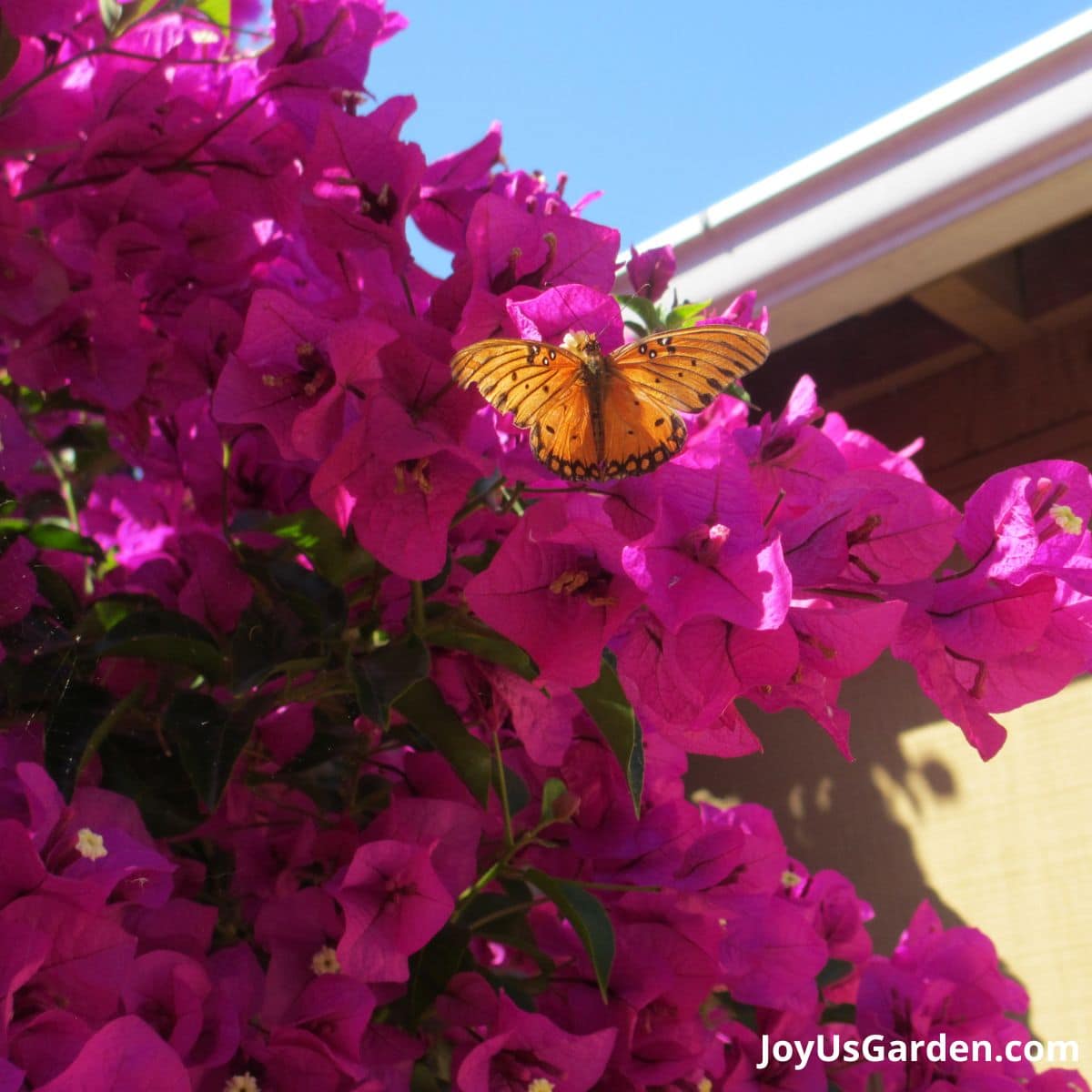
Sun Requirements
Bougainvillea needs at least 6 hours of full sun daily to flower profusely and look its best. This plant also loves the heat. Not enough sun = not enough color.
If you live in a climate where bougainvillea is borderline hardy, planting it against a warm wall or in a corner against the house will help. Remember, this popular plant that loves sun and heat!
Got questions about growing bougainvillea? We’ve got the answers!
Check out our in-depth Bougainvillea Guide, designed to help you grow this beautiful plant with confidence. Click the link to learn more. Happy growing!
Watering
When it comes to watering, bougainvillea is fairly drought-tolerant once established. It prefers a good, deep watering every 3-4 weeks rather than frequent shallow watering.
Give your bougainvillea regular water when establishing (in the first couple of years). It’s subject to a few types of root rot, so don’t over-water. The soil should be well-drained, helping to prevent rot.
I never supplementally watered my bougies in Santa Barbara because they were older and well-established. I lived seven blocks from the beach, so they got spring and summer moisture from the maritime layer.
In Tucson, my bougainvilleas look best when watered (via drip irrigation) for an hour a week in spring, summer, and early fall.
Another result of too much water – is more green growth and fewer flowers. No, thank you – flowers, please!
Do you have questions about this plant? Click here for answers to questions about Growing Bougainvillea.
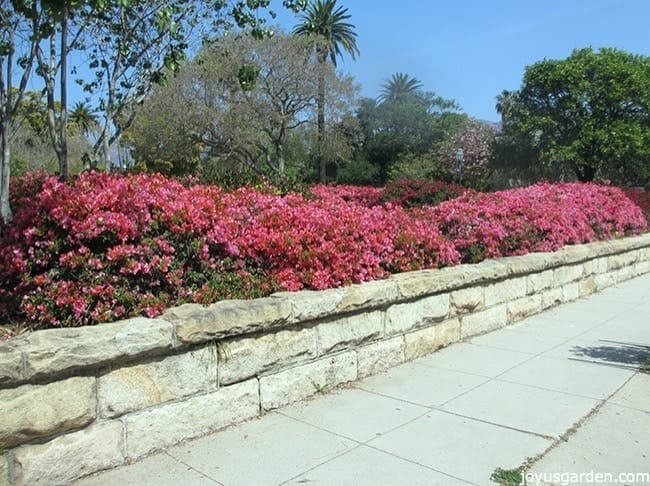
Fertilizer
I’ve never fertilized bougainvilleas when planting or as part of maintenance. I feed them with compost – a good dose upon planting and a 3″ topping every year or two in late winter/early spring.
I used to work at a Berkeley Horticultural Nursery, where a grower recommended fertilizing them with palm and hibiscus food one or two times (in late spring and mid-summer) during the active growing season. This bougainvillea fertilizer gets high ratings and would be another option.
Be sure to follow the directions on the box – an application once or twice a year will be just fine.
Pests
In my Santa Barbara garden, aphids could be an issue on the new growth of my bougainvilleas in early spring. I just sprayed them off with a gentle blast of the garden hose. Spider mites are another common plant pest to be on the lookout for.
The bougainvillea looper caterpillar has been an issue with my bougies in Arizona and California. They’re green, brown, or greenish-yellow and tiny – maybe 1″ long. They feed at night and chew mainly on the leaves. I just let them be, and they eventually go away. Because my bougies drop many leaves in the winter, it’s not an issue for me.
A few years ago, leafcutter bees enjoyed one of my bougainvilleas, which you’ll see in the video, but now they moved on. They move fast and are valuable pollinators for many plants. For that reason, I let them be, also.
You might find this post on What’s Eating My Bougainvillea Leaves helpful.
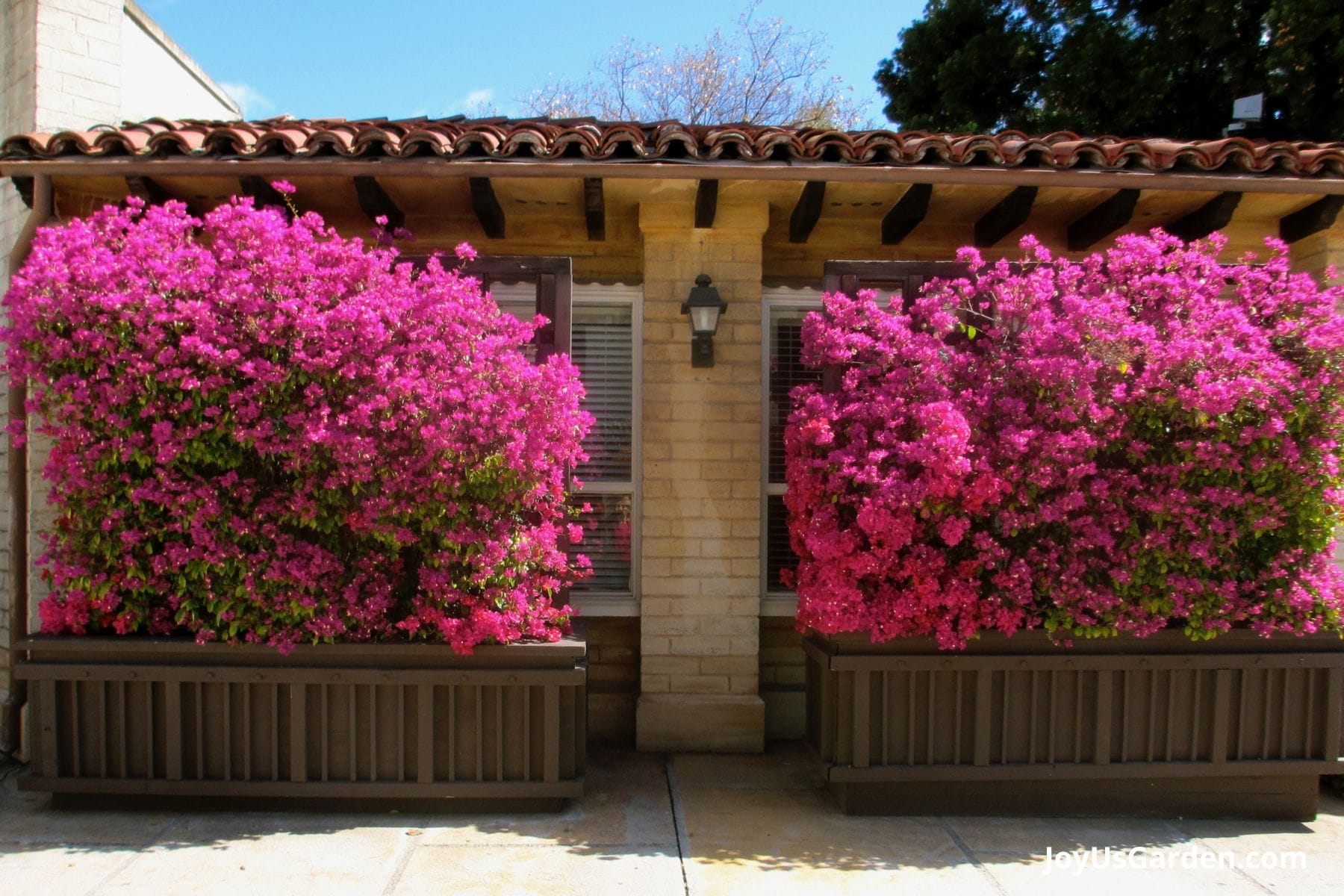
Soil
This plant needs well-draining soil when growing in the ground or in a pot. Find more on bougainvilleas in containers further on down.
When I plant bougainvilleas in the ground, I add loam from a local landscape supply company (if the existing soil needs it) and organic matter.
Transplanting/Planting
Planting or transplanting bougainvillea is best done in the warmer months. Depending on your zone, that’s anywhere from March through October.
One of the most important things to do is to choose the appropriate location. Bougainvilleas and sunshine go hand in hand.
I’ll briefly touch on transplanting and tell you it’s a crapshoot. Bougainvilleas don’t like to have their roots disturbed. I’ve never transplanted one and don’t recommend it.
You’d be better off just buying a new plant. If you try transplanting yours, just be as careful as possible not to injure those sensitive roots.
I’ve done a post and video on Planting Bougainvillea, which includes all the steps and an important thing to know.
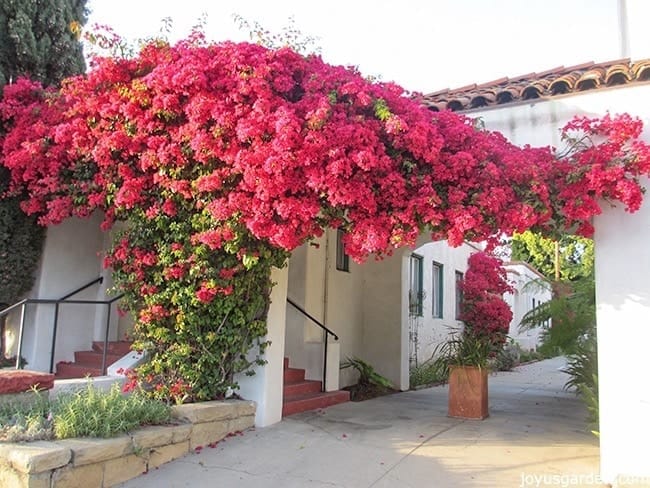
Supporting/Training
The taller growing bougainvillea vines need strong support and require training and to be tied. They aren’t attaching or twining vines. Make sure the ties you use are strong and that you tie them well – some of their branches get to be good-sized.
I trained my Bougainvillea glabra in Santa Barbara to grow up and over my garage. Once it got higher than the door, I secured it to a large metal trellis (bolted to the top center of the garage), and it grew all the way across. You can see this in the photo below.
They can be trained on a trellis, over an arbor, on a fence, or across a structure. The lower-growing varieties are suited to be hedges, ground covers, and free-form shapes (I’ve seen one pruned into a swan shape and another into a giant basket).
The best time to start the training process is when or soon after planting.
I trained my Barbara Karst in Santa Barbara into an “umbrella tree.” Bougainvilleas are also suitable bonsai plants; I’ve seen some beautiful specimens.
Pruning
I gave mine their big pruning in late winter in Santa Barbara and early spring in Tucson. This sets the tone for how I wanted them to grow and look throughout the season. I did two or three lighter prunes after each bloom cycle.
Bougainvillea blooms on new growth. You want to prune and pinch yours to bring on the flowering. If you pinch the tender ends, which are about to bloom, the show of color will be denser and not all at the ends.
A word of warning: all bougainvilleas I’ve come across have sharp thorns, so use caution and wear gloves when pruning. If you’re not careful, you can come out from a round of pruning looking like you’ve been in the lion cage!
I’ve done five posts and videos on how to prune bougainvillea in this round-up: Bougainvillea Pruning Tips: What You Need to Know.
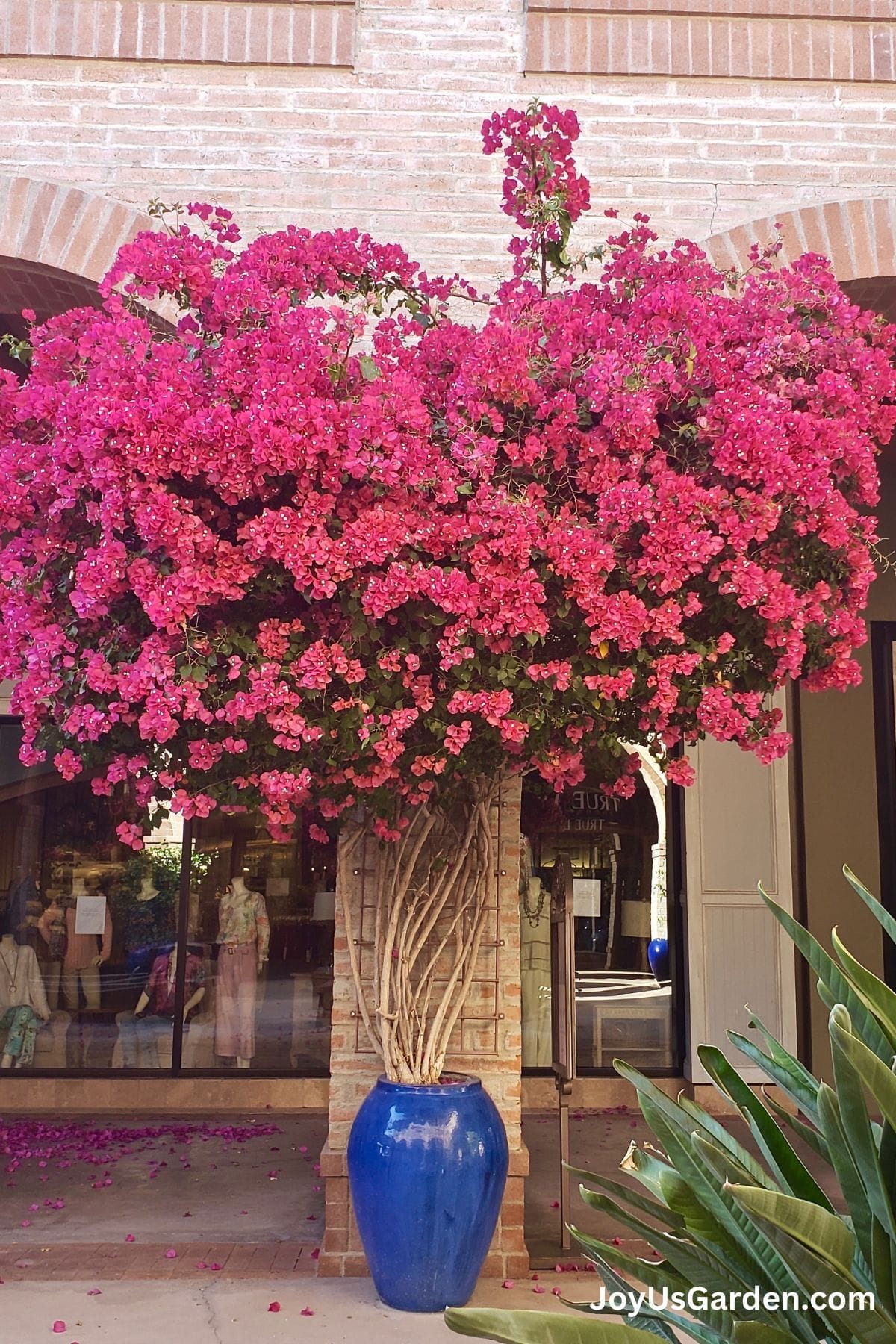
Bougainvillea In Containers
I’ve written dedicated posts about planting bougainvillea in pots and bougainvillea care in pots which you’ll find below.
It does fine in containers, but I’d recommend using one of the lowing growing varieties of bougainvilleas for this.
Large bougainvilleas, like the one pictured above, need large containers. A taller one will need a large pot to accommodate the large root system.
Bougainvilleas need good drainage. A good organic potting soil mixed with a good dose of compost would make this plant happy. Make sure there are drainage holes on the bottom of the pot so the excess water can flow out, preventing root rot.
Are you interested in more info? Details here on Planting Bougainvillea In Pots. Do you need care tips? You can also read about How To Care For Bougainvillea In A Pot.
Bougainvillea In Winter
I don’t do much to bougainvillea in the winter months. Rather than further detail here, please refer to the article below.
I have written six posts plus answered FAQs on this subject in the following round-up: Bougainvillea Winter Care Tips.
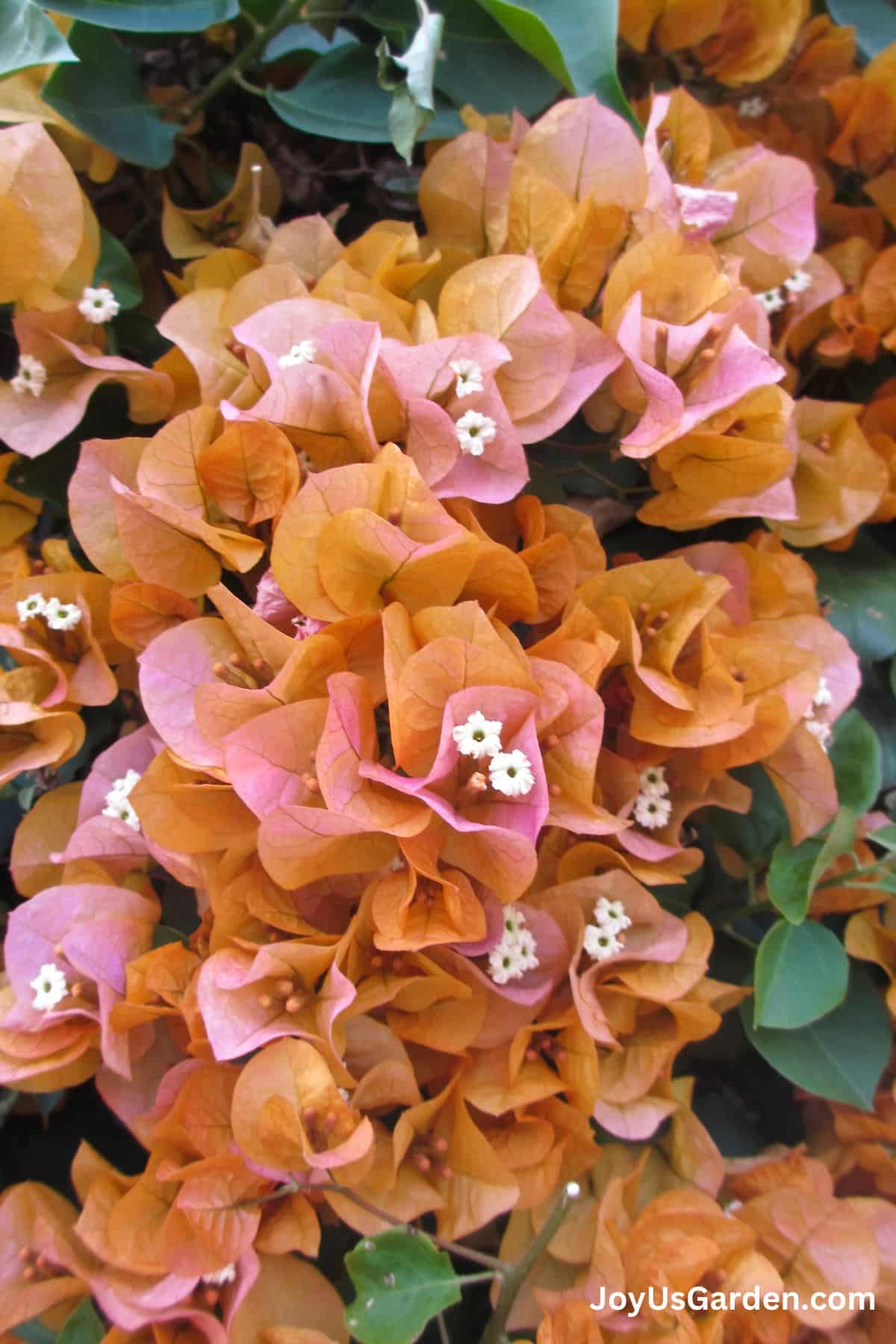
Bougainvillea Flowers
I’m saving the best for last! These flowering machines will bloom off and on year-round in warm climates. In a climate where the winters are cooler, they’ll bloom for 9-10 months.
The tiny white flowers in the center and the bracts (the colored leaves) give us those big shows of color. Bougainvilleas put out an explosion of color, drop their bracts, and then flower again.
You can find bougainvilleas in white, yellow, gold, orange, pink, magenta, red, reddish-purple, and purple. Some have 2-toned colors and variegated foliage too—something for all, except you lovers of blue.
The color of bougainvillea can change after you plant it. This has to do with breeding. My bougainvilleas, all well-established, will change color a bit as the season progress.
When the temps are cooler, the color is more intense. Here in Tucson, my bougainvilleas all have deeper colored flowers in early spring but will become less intense when it gets really hot. My “Rainbow Gold” has newer orange flowers that fade to pink.
If your bougainvillea is growing in part sun, the color could be a bit off. The bottom line: the warmer the spot is where your bougainvillea is growing, and the more sun it’s in, the more bloom and color you’ll get.
Do bougainvilleas bloom year-round? This is a question I’ve gotten over the years. The answer is yes and no. They go through bloom cycles that last anywhere from one to two months, and then the bracts fall.
In Santa Barbara and Tucson, bougainvilleas show color eight to ten months out of the year. My friend in Hawaii also says it’s cyclic there but blooms pretty much all year. The bottom line is that when an established plant is in bloom, you get a lot of color!
Bougainvillea Care Video Guide
Looking to master the art of growing bougainvillea? We’ve got you covered! Explore our Bougainvillea Tutorial package, complete with videos and PDFs, plus our concise ebook, Growing Bougainvillea Successfully. These resources offer everything you need to cultivate stunning, vibrant plants with ease.
Bougainvillea Care FAQs
Bougainvillea needs at least six hours of direct sunlight daily to look its best and flower profusely. This isn’t a plant for afternoon shade. Not enough light = not enough flowering!
Make sure it’s getting enough sun and heat. Also, bougainvillea plants flower on new wood, so if you prune and/or tip-prune once or twice a year, you’ll get a more concentrated bloom.
Bougainvillea goes through blooming cycles throughout the year, so there will be periods when it’s not showing color.
You probably won’t see significant growth with your new plant in the first year or two. As it ages, with proper care and favorable growing conditions, bougainvillea takes off and is fast growing.
Give the large varieties plenty of room to grow. If you want a bougainvillea that stays around 5′, buy a lower-growing variety.
Yes, it certainly can. Young plants are particularly susceptible to a freeze. This tropical beauty is known for its vibrant hues and ability to thrive in warm climates, making it a popular choice for gardens worldwide where temps don’t dip below 32F in the winter.
Everything I share with you is based on experience. I’ve never grown bougainvillea indoors and don’t know anyone who has.
Remember to give them plenty of sunlight, water regularly but not too much, and prune them when necessary to keep them looking and flowering their best. Bougainvillea care takes a bit of effort, mainly in pruning and sweeping spent blossoms, but in my book, they are well worth it for their big shows of color. Carmen Miranda would approve!
Note: This post was previously published on 5/7/2017. It was updated on 8/13/2020 & then again on 5/31/2023.
Happy gardening & thanks for stopping by,

This post may contain affiliate links, you can read our policies here.
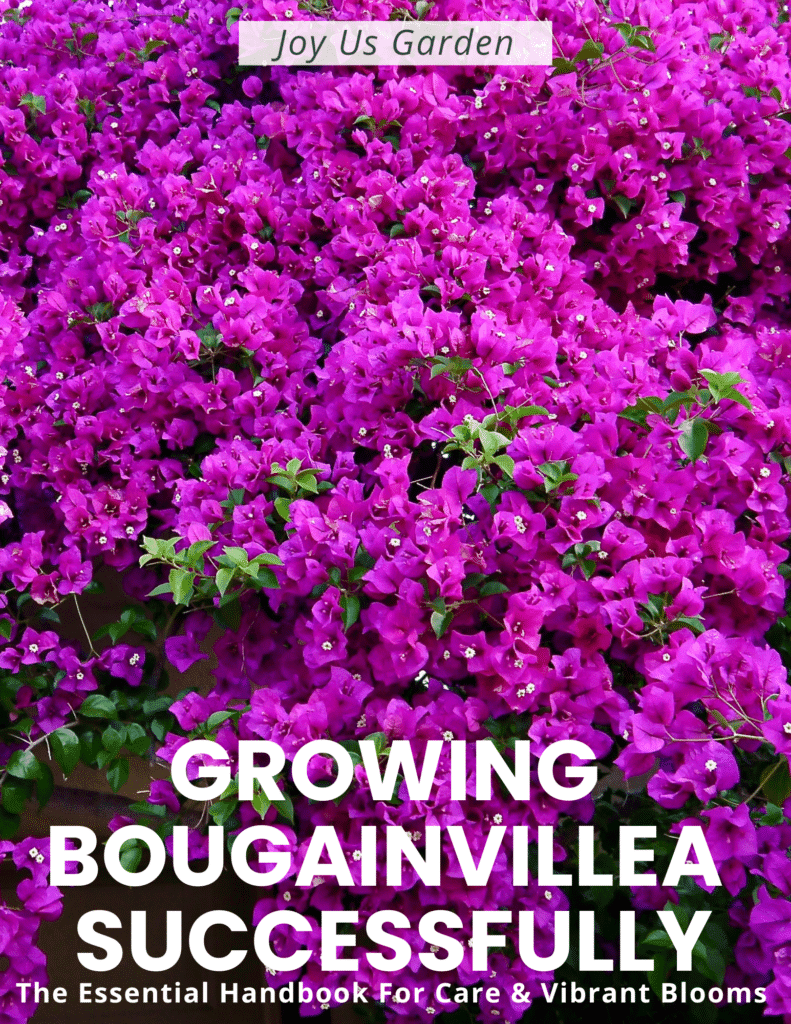
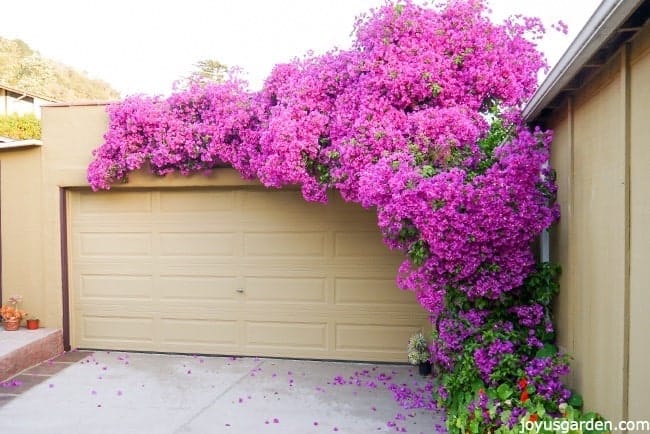

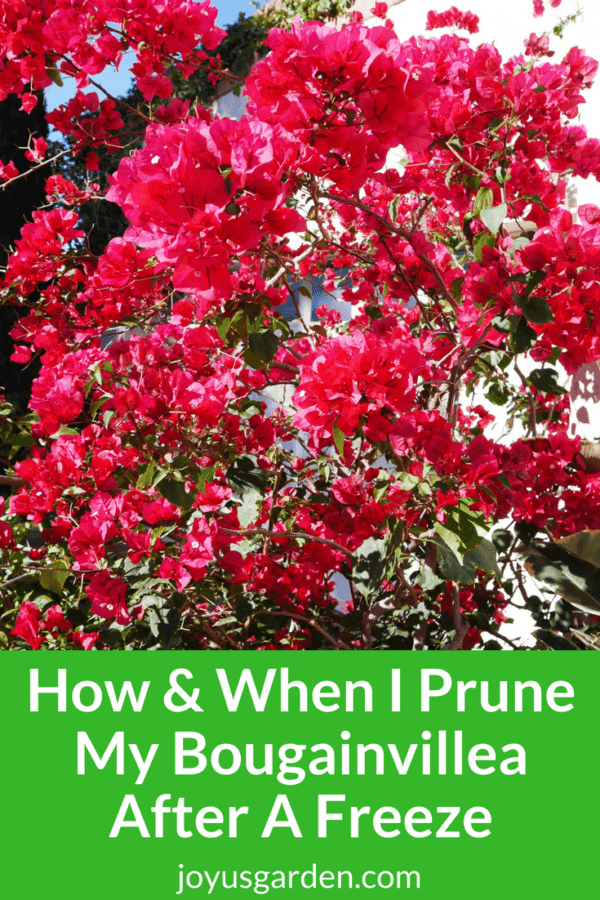
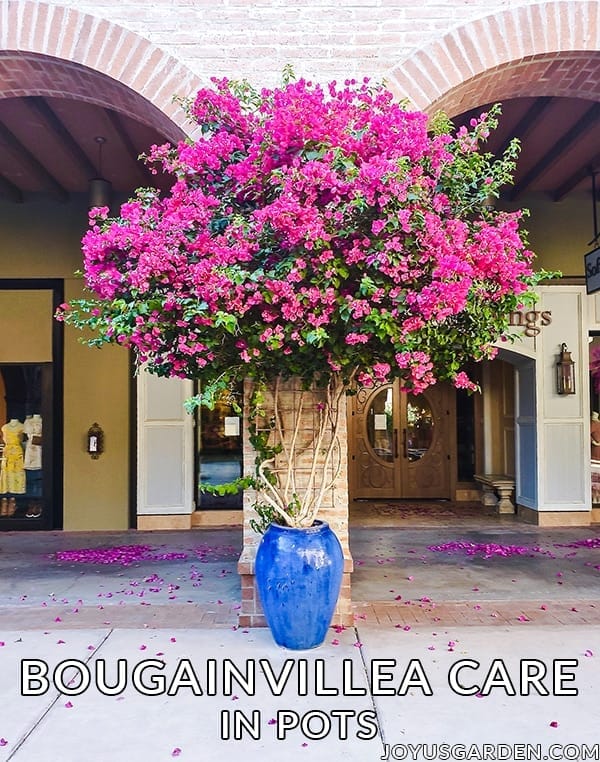
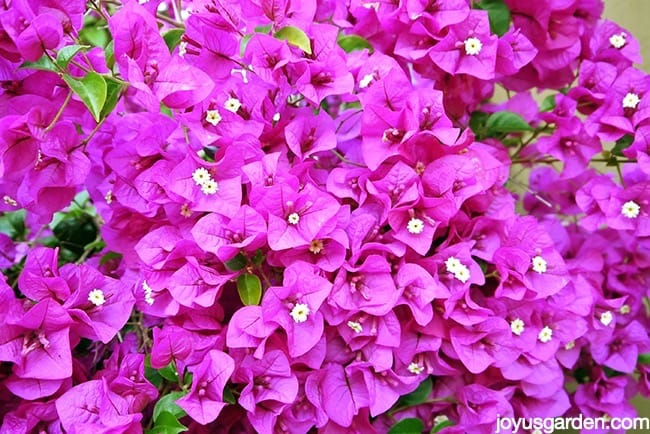
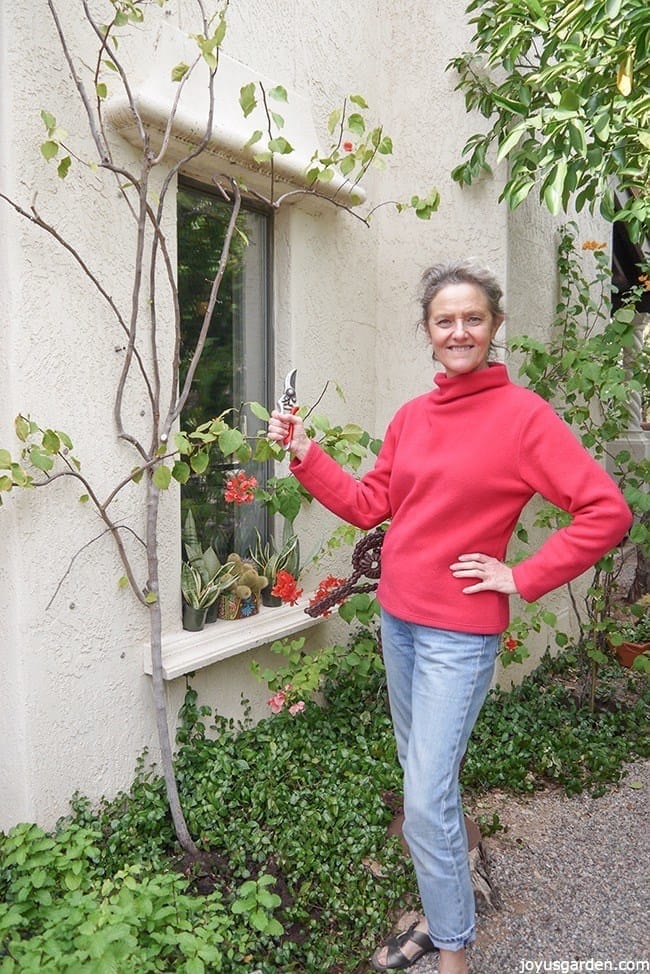

Nell please make a video of gardenia shrub or trees. I have one indoors and I have no idea how to care for it, thanks
Nell- Living in North Phoenix, maybe 5 degrees hotter than Tuscon. How often should I deep water in our hot summers, plants are 2-3 years old. Also soil is sand and granite granuals. Do I fertilize lightly through the summer?
Hello… I’ve got 2 bougainvillea’s that are 4 years old. I bought them in hanging baskets and the first year they were PROLIFIC all summer and into the fall. LOTS of blooms, thick, flowing nearly to the ground…. perfect!!! (note, I live in NE texas zone 8) The first winter, I did not bring them in and the cold weather got them pretty good. Year 2 the plants came back with leaves but VERY few flowers. I transplanted them into larger baskets (24 inch) before year 3 and same thing… foliage but virtually no flowers. The main stems are thick (1/2 inch) and very woody and “stringy and stiff”. This winter, they are in a greenhouse staying warm but they have both lost most leaves…. HERE’S MY QUESTION… If I prune them back this winter…. will that help them come back in the spring with new growth that will be “softer” and “flow” over the basket? I’d hate to lose them since they are mature now and are well established in the larger baskets…
Hi Byrne – If bougainvilleas get hit hard by a cold spell, they’re slow to come back. Bougainvilleas don’t like to have their roots disturbed. If they have to be transplanted (not a good ideA), it’s best to do it grow pot & all. https://www.joyusgarden.com/how-to-plant-bougainvillea-to-grow-successfully-the-most-important-thing-to-know/ Most bougainvilleas are deciduous or semi-deciduous at this time of year. I’d wait another month or so for the pruning. Some bougies grow more vigorously than others so it depends on your variety. The pruning will help encourage that new growth. Nell
Nell, what a find to come across your utube videos and what really makes me happy is to find someone that has a passion and love for my absolute favorite flowering plant! I am so excited to learn as much as I possibly can about them. I live in Desert Hot Springs, CA 92241 and they are every where you look. I just love looking at them! They just give me so much joy when ever I see them! I don’t have any in my yard because my husband insisted not to have them, he always thought they were to messy. But I am like you and would think the clean up would be well worth it! I intend to have them in my yard since I am now by myself. I want to learm as much as I can before I buy some and my exciting new adventure begins. I’m not familiar with YouTube so I have no idea what the process is to join. Meaning the cost and just all of what I need to know about joining your site. Thank you Nell for all that you have done and for sharing your beautiful bougainvillea. I love them! Looking forward to hearing from you!
Hi Gloria – Bougainvilleas are extremely popular so I think a lot of people agree with you & me. I call them a mess but a beautiful one. There are smaller bougainvilleas so you can look into starting with those. They do better in containers than the taller growing ones do. Youtube is free so watch any of the videos you’d like to. You just need to create an account 1st. I post videos on lots of other plants so be sure to check those out too. Thanks for stopping by! Nell
I have transplanted bougainvilla successfully and not used the grow pot. Some large, some small. In fact one was dead, I thought. Inches high. I had nothing to lose. Dug a hole and stuck it in. It’s wonderful now. I live in Florida so perhaps this is just the perfect climate. We get a lot of rain in the summer, doesn’t seem to bother them. The sandy soil is their friend. Been cutting some back radically lately, I had some branches grow into a tree up to around 25 feet. I want the main plant to be focused in front of a fence ( nieghbor has 7 dogs, just don’t want to look at the mess).
Hi Beth – That’s good to know; thanks for sharing. Your climate is much different from ours. And yes, a beautiful bougainvillea is much better to look at than the neighbor’s mess! Nell
NELL FOSTER, What is the name of that flower/plant that you are holding?
I really want to get some. I live in southern CA.
thanks
Hi Farrin – I don’t know what plant you’re talking about as I’m not holding any in the pics in this post. Wish I could help! Nell
I had a Bougainvillea bush planted about a month ago. When it was planted it had lovely flowers blooming on it . About a week later, after a very windy time, the flowrts were blown off and it has not bloomed since then. I live in central FL. Temps not below 40, just windy. Wray can I do to get my tree to bloom?
Hi Nell,
I love bougainvillea but I live in zone 6 (NY) and I know they are not winter hardy here. I bought one in a small pot today and will keep it in for a few more weeks before planting it outdoors. Any advice for us shorter season folks who still love this plant?
Hi Cynthia – Bougainvillea needs as much high light indoors as you can give it. Back off on the watering in the dry months & keep the plant on the dry side. If you plan on planting it outdoors, here’s something you should read 1st: https://www.joyusgarden.com/how-to-plant-bougainvillea-to-grow-successfully-the-most-important-thing-to-know/ Nell
Hi Nell, I belong to a club that sends freebees once in a while. I got a small bougainvillea today in the mail. I live in Northern Michigan and I’m not sure I should even plant it. What do you suggest? Thanks so much.
Hi Gail –
It depends on how much work you want to put into it! Bougainvilleas love sun & warm weather & to be kept on the drier side. You’ll definitely have to grow it in a container & bring it in in the colder months. If you don’t have high light somewhere in your house & warm summer months (75-80F plus) the bougainvillea most likely won’t do well. Nell
Article is very informative. I live in Oxnard, CA
Neighbors put up a 7′ concrete wall between our properties. on their side of the property. On my Esact side I was thinking of planting about three redwood planter with bougainvillea and place up against the wall to break up the monotony of the concrete However, their property is a 2 story and I question if it would get 6 hors of sun daily. Cooments?
Hi Lee –
Bougainvilleas need all day sun to look their best & flower. And, in the winter, there will be even less sun. If there isn’t enough sun, go with another plant choice. Nell
Hi, will they stand indoor temperature with AC ?
Hi Nivi – They love the warm summer & fall temps. I have no experience with growing bougainvilleas indoors with air conditioning. In my opinion, it wouldn’t be what they’d like or do well in. Nell
Hi Nell,
am planning on buying a bougainvillea for the balcony, but am not sure if it can pass the summer in (Kuwait), consider the following:
– June to August temperatures reach 122 day and 106 night.
– balcony is in the 2 floor.
– I have 6 hours of sunlight.
– its going to be planted in a large pot.
great site really appreciate it.
Mohammed
Hi Mohammed – Thank you; glad you found us. 122 for 3 months is hot. That being said, I live in Arizona & the summer temps in Phoenix are consistently 100 – 110 or so. Bougainvillea grows there. I live in Tucson where it’s slightly cooler. My bougainvilleas don’t bloom well in the heat. It should grow fine, but because it’s going to be planted in a big pot, use good soil. You’ll have to water it more often. Here’s a tip for planting it: https://www.joyusgarden.com/how-to-plant-bougainvillea-to-grow-successfully-the-most-important-thing-to-know/ Nell
Hi I love bougainvilleas and would like to plant several in my yard. I have no flower beds due to poor soil, my whole yard is hard pan. I live in Sacramento ca. I have recently put in concrete sidewalks with the intention of having large planters for greenery. Would bougainvilleasay do well in a pot and how large does it need to be?
Hi Jeanette – Yes, bougainvilleas do fine in containers. Over the years, the taller growing varieties will get pot bound. It’s hard to say how big the pot should be because I don’t know what varieties or species you’re planting. The bougainvilleas which get 3′ tall of course will do fine in a pot that’s much smaller than those which grow to be 25′ tall. If you buy both the bougies at a reputable garden center, they’ll be able to help you. Nell
Hello,
I snipped off some of the boungainvillea plant from my neighbor and put it in water. Hoping it will get roots and then I can plant it? Or should I just go and buy one? But I really like the color of the one that my neighbor has 🙂
Hi Sapna – I’ve never propagated bougainvilleas because I’m way too impatient for that! I know someone who has & he did it successfully in medium rather than water. I believe he covered the cuttings with a glass cloche. If you buy one, here’s a post I did on that: https://www.joyusgarden.com/how-to-plant-bougainvillea-to-grow-successfully-the-most-important-thing-to-know/ Nell
Can they handle being near brackish saltwater spray occasionally?
It should be fine Carin; occasional spray won’t hurt them. If too much absorbs into the roots, it will. I lived in Santa Barbara, CA for 10 years & bougies grew along the ocean just fine. Nell
In georgia, so have mine in a pot because have to bring it in during winter. Came back nicely this spring but now is wilting every afternoon.
It has been about 88 degrees. But I thought they like heat. Any reasons for the wilting?
Hi Heidi – I live in Tucson AZ where the temp is currently 102F & my bougies are looking fine. The wilting is probably due to too much or too little water. Nell
I bought my bougainvillea in a hanging pot. It is on the patio where it gets sun. Lately the flowers are dropping looking faded. We have had a lot of rain as well as over 90 degree heat. What. Needs to be done to get it to bloom again?
hi Sandra – Bougainvilleas go through a period of rest after blooming before setting flowers again. My Barbara Karst is in that phase right now (mostly green) but I can see there are a lot of blooms setting. You can give it a light trim if you want because bougies bloom on new growth. Nell
I live in zone 5, Kansas City. I bought a sad little Bougainvillea this spring. With the intense heat my north facing deck gets the plant is beautiful , blooming and growing. I’ve never had such luck with these plants and am heart broken thinking it will die when our weather changes and I bring it inside. Any ideas of how I can keep in alive in a Kansas winter?
Hi – Bougainvilleas can be tricky to grow indoors. They need high light, south or west exposure, with lots of sun. Keep the soil on the drier side & don’t fertilize. Nell
Enjoying three beautiful coloured bougainvilleas, but would love to know when we should consider pruning them and if it’s OK to do this with a hedge cutter, rather than shears?
Hi Louise – They can be pruned with hedge cutters because that’s what many commercial gardeners use. If they’re growing as a hedge, that would be fine & a way to keep them even. I always use pruners because I prefer the more natural & open look. It’s your choice! Nell
I live in central minesota and habe 2 beautiful potted plants how successfully do they winter inside?
They ca be tricky indoors Jerry. I only know 1 person who’s successfully over wintered 1 indoors but she has a sunroom. They need high light & lots of sun. Also, if you do try it, back off on the freqeuncy of the watering in the colder, darker months. Nell
Hi, One shoot with enormous leaves, at least twice the size of the other leaves, has sprouted from my bougainvillea. What is this? Should I cut it off? Will it bloom? Thanks!
Hi Diana – Those are water shoots & should be taken off. You can read more about them here: https://www.joyusgarden.com/check-bougainvilleas-october-tips-coming-way/ Nell
Hi I live in NJ and need to know how does it survive indoors in winter. Will it just remain dormant and can revive outside in summer? I really don’t want to lose it.
Hi – It’s not winter hardy in NJ (only zones 9-11) so you’ll have to bring it inside. It can be tricky to over winter though. Nell
Is bougainvillea deer resistant? And, used as ground cover, does it prevent the growth of weeds, grass, etc? What variety is best as ground cover?
Hi – Yes, it’s considered to be deer resistant. But, if they’re hungry enough, they’ll munch on almost anything. I’ve never used it for weed control. You’ll find low growing varieties in this post: https://www.joyusgarden.com/bougainvillea-care-in-pots/ Nell
why do my colorful bracs have on the tips of their petals a almost translucent color? I know that is not right???? is that a sign they are ready to fall of the green leaves???
thanks Nellie
Nellie – Translucent bracts are usually a sign the flowers are fading. Some varieties have bracts which are more translucent than others. Nell
Hi Nell,
I am a total newbie on gardening and fell in love with the Bougainvilleas for their blooms so I bought two Imperial Delights not knowing anything about them.
They did great for one month then lost all their blooms it took me a minute to figure out they had been infested by aphids. By the time I got it under control they were mostly dry sticks. Since then I have added fresh compost, ground coffee, water only twice a week and moved them to a different part of the house where they get full sun.
I am getting some green and some blooms but nothing compared to what they originally looked like.
I am in Central TX and we are in the 80s to high 90s from May through Oct.
I would love your advice.
Many thanks
Connie
Hi Connie – I’ve never grown bougainvilleas indoors so I don’t have any experience to share with you. I know it can be tricky. Give them the highest light possible& water only when the top half dries out. They prefer being grown outdoors & may be in shock espceially if you took them out of the grow pots to plant. Nell
Hi there, have bougainvillea bushes in my front yard. A few have died. I have gaps and would like to fill the spaces. Can I cut a branch from my bush and replant the branch as long as it’s alive and well?
Hi Jennifer –
I’ve never propagated bougainvillea. I know someone who did via stem cuttings in propagation mix, not by planting it in the ground. Nell